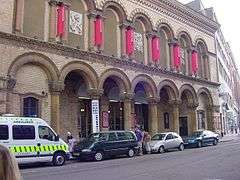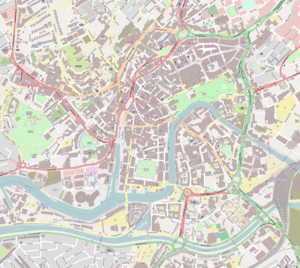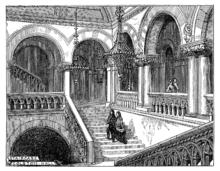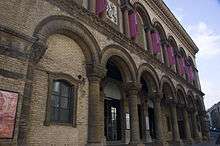Colston Hall
Colston Hall is a concert hall and Grade II listed building on Colston Street, Bristol, England. It is owned by Bristol City Council and was named after the slave trader, merchant, philanthropist and Member of Parliament, Edward Colston, who founded Colston's School on this site in the early 18th century. Since 2011, management of the hall has been the direct responsibility of Bristol Music Trust.
| Colston Hall | |
|---|---|
 Colston Hall in 2005 | |
 Colston Hall Central Bristol | |
| General information | |
| Town or city | Bristol |
| Country | England |
| Coordinates | 51.4546°N 2.5981°W |
| Completed |
|
| Client | Corporation of Bristol |
| Design and construction | |
| Engineer |
|
The hall first opened as a concert venue in 1867, and became a popular place for classical music and theatre. In the mid-20th century, wrestling matches were in strong demand, while in the late 1960s it developed into one of the most important rock music venues in Britain. The hall has been redeveloped several times, and was gutted by two fires in 1898 and 1945, though the original Bristol Byzantine foyer has survived. A major refurbishment, adding an extra wing, opened in 2009 and redevelopment of the cellars is planned by 2019.
The hall's official capacity is 2,075, with an additional 350 in "The Lantern", built as part of the 2009 redevelopments. As well as the main entertainment areas, there are a number of licensed bars and a restaurant.
in 2017 it was announced that following renovations Colston Hall would reopen in 2020 with a new name. The change reflects concerns over the association of Colston with the slave trade. The new name is yet to be decided, but as part of fundraising plans it is hoped to be in recognition of a commercial partner.[1]
History
There has been a building around the location of Colston Hall since the Middle Ages. During the 13th century, a Carmelite friary called Whitefriars stood on this site.
In the Tudor period, it was replaced by a mansion called The Great House. The Great House was built in 1568,[2][3] by Sir John Young. Sir John was the descendant of a merchant family and courtier to Henry VIII.[4][5] Queen Elizabeth I stayed here as a guest of the Youngs when visiting Bristol in 1574.[6]
In the late 17th century, a sugar house was established here by the merchant venturer Edward Colston to refine sugar that was brought in from the Caribbean to Bristol Harbour.[7] The sugar refinery included thirteen cottages for workers in its grounds which extended towards the current sites of the Red Lodge Museum.[8]
In 1708, Colston established the Colston Boys' School in this building in order to educate the poor. It was managed by the Society of Merchant Venturers.[9] Colston adhered to a strict moral and religious code which was enforced in the school.[7] After his death in 1721, the school continued at the Great Hall until 1857, when it moved to Stapleton.[6]

The site was acquired by the Colston Hall Company in 1861, who raised £12,000 in £10 shares.[10] They demolished the old school building in order to build a concert hall. The venue opened on 20 September 1867.[6] The architects were local firm Foster & Wood, working in the Bristol Byzantine style.[11][12] The basement was used as a bonded warehouse handling the cargoes from the docks.[13] The original hall included a coffered barrel-vaulted ceiling, and was modelled after St George's Hall, Liverpool.[14] The foyer building with the grand staircase and smaller hall were opened in 1873.[15] A meeting calling for Women's suffrage was held at the hall in November 1880.[16]
On 1 September 1898, a fire broke out in the neighbouring Clark's clothing factory, which quickly spread to the hall, while it was in use for the Trades Union Congress.[17] The auditorium suffered extensive damage, with only the walls remaining, and the pipe organ was completely destroyed.[6] The foyer was the only part of the building to survive in its original condition.[18]
The hall was rebuilt and re-opened in 1901.[19] It was in use throughout the First World War; In 1915, David Lloyd George addressed a meeting in the hall to discuss the production of munitions, while in 1919 a Roll of Honour took place there for soldiers who had been decorated for their service during the war.[19] The Bristol Corporation, which later became Bristol City Council, bought the building for £65,000 in 1919.[20]

The second hall was closed for remodelling in 1935, as it was difficult for all of the audience to see the orchestra performing. It re-opened the following December.[19] Though much of Bristol was bombed during the Battle of Britain, the Colston Hall survived most of the Second World War. On 5 February 1945, a discarded cigarette started a large fire that burned down the hall for a second time. The organ was destroyed, and the main auditorium was reduced to pieces of charred wood and hot metal.[21]
The hall was refurbished and initially used in 1951 to commemorate the Festival of Britain.[22] It was designed by J Nelson Meredith and constructed by William Cowlin.[14] It included improvements in the building's acoustics and a modern heating and ventilation system.[22] The organ was rebuilt by Harrison & Harrison and housed in a grille behind the stage out of view of most of the audience. It has 5,372 pipes, ranging from 1 inch (whistle) to 32 feet (sub-bass).[18] Acts from the US began to appear at the hall, having been restricted by the Musicians' Union for the previous 20 years.[22] In 1966, the building was Grade II listed by English Heritage.[14]
The first computerised booking system was installed in February 1983.[23] In 1990, the hall briefly closed as part of a £500,000 modernisation programme to rewire the building and improve the technical facilities, as well as redecorating the backstage area. In 1999, removable seats were installed in the front of the stalls, in response to rock concerts where fans at the front wanted to move around freely, as well as increasing capacity.[24] The official capacity of the hall is now 2,075.[18]

From 2007 to 2009, the Colston Hall underwent extensive refurbishment with the construction of a new foyer alongside the present building by Willmott Dixon, topped by a wind turbine.[25][26] As part of the redevelopment, the old bar area (called the "Little Theatre" or "Lesser Colston Hall") became a performance space called "The Lantern". The venue can accommodate a standing audience of 350, and has additional performance spaces, meeting rooms, and restaurants.[27] In 2011, management of Colston Hall transferred from Bristol City Council to Bristol Music Trust.[18]
In 2014, the Bristol Music Trust announced a fundraising campaign to raise £45 million to refurbish and modernise the main hall. Proposed works include converting the cellars into studios, as well as other internal modernisations. By 2016, £25 million had been raised by Bristol City Council, the national Government, and Arts Council England. Work began in 2019, carried Willmott Dixon, with completion set for 2021.[28][29]
Artists and performers
Classical
Details of early performances at the hall are limited due to the subsequent fires, but the archive of the Royal College of Music holds programmes from 1896 onwards which reference a triennial musical festival that was founded in 1873, as well as performances by the (long defunct) Bristol Symphony Orchestra.[30] The British Library holds details of the 1912 festival at the hall which, among other concerts, included a performance of Wagner's Ring Cycle over four days.[31] It is known that the great pianist and composer Sergei Rachmaninoff performed at the hall in the 1920s,[32] and a concert programme from 1969 lists forthcoming weekly classical concerts with soloists such as Arthur Rubinstein and Igor Oistrakh as well as the Bournemouth Symphony Orchestra, the (now defunct) Bristol Sinfonia, conducted by Sidney Sager[33] and concerts by Bristol Choral Society which has staged at least three concerts annually at the Hall since its formation in 1889.[34]
There is an annual International Classical Concert Season[35] featuring regular appearances by the Bournemouth Symphony Orchestra and visiting UK and international orchestras such as the London Symphony Orchestra,[36] Philharmonia Orchestra,[37] the Moscow Philharmonic Orchestra, Warsaw Philharmonic Orchestra and Berliner Symphoniker in the 2011–12 season,[38] as well as solo artists such as Murray Perahia.[39]
The hall can stage theatrical productions. From 22–30 December 2011 it hosted 15 performances of the Bristol Old Vic production of Coram Boy while the Old Vic was closed for refurbishment.[40][41]
Rock
Colston Hall has been a popular venue for many rock and pop music acts since the 1960s. The Beatles first performed at the hall on 15 March 1963 as part of a package tour with Chris Montez and Tommy Roe. The group returned there to play the last gig of a British tour on 10 November 1964, where four fans managed to sneak backstage and tip flour over their heads. Jimi Hendrix played twice at the hall during 1967.[42]
From the late 1960s onwards, Colston Hall became one of the major rock music venues in the country. The Rolling Stones, David Bowie, Elton John, Queen, Thin Lizzy, Roxy Music, Iron Maiden, Bob Marley and Lou Reed all performed there.[43] The Who first played Colston Hall on 10 November 1968, part-way through recording Tommy, with support from Free, and returned on 7 March 1970.[44] Led Zeppelin played at Colston Hall in June 1969, part-way through recording Led Zeppelin II.[45] Pink Floyd gave one of the first live performances of The Dark Side of the Moon at Colston Hall on 5 February 1972, over a year before the album was released.[46]
Queen headlined Colston Hall three times, firstly on Tuesday 12 November 1974 as part of the Sheer Heart Attack Tour, returning on 17 and 18 November 1975 as part of the A Night At The Opera Tour. Subsequent tours would see them play at the Bristol Hippodrome.
Comedy
In addition to rock and pop artists, the Hall regularly hosts comedians (including multiple-date sell-out runs by Billy Connolly[47] and Bristol-born Stephen Merchant[48]). An annual silent comedy festival takes place there.[49]
Wrestling
Colston Hall was popular for wrestling matches from 1951.[22][50] By the end of the decade, demand for matches was so strong that seats were block booked from one day to the next. Harold Sakata made several wrestling appearances there before moving into acting in the 1960s. The last match was held in 2004; though an official reason was not given, locals believe it was no longer an appropriate image for Colston Hall.[51]
Proposed renaming
Campaigners, many from the city’s African Caribbean community, have called for the hall’s name to be changed because of Edward Colston’s involvement in the slave trade,[7] much of his wealth having come from that trade, and his investments in the Royal African Company.[52] The Bristol group Massive Attack vowed not to play at the venue while it retained its present name.[52] The proposal led to a debate in the pages of the local press; the majority of letters printed favoured retaining the Colston name.[53][54]
In April 2017, the charity that runs Colston Hall announced that it would be dropping the name after refurbishment is completed in 2020.[55] On 15 June 2020 the lettering "Colston Hall" was removed from the hall's exterior, and the Trust announced that a new name would be disclosed later in 2020.[56]
References
Citations
- "New Hall, new name". Colston Hall. Retrieved 26 April 2017.
- "Feuding Gentry and an Affray on College Green, Bristol, in 1579" (PDF). Bristol and Gloucestershire Archaeological Society. 2004. Archived from the original (PDF) on 29 October 2013. Retrieved 16 September 2013.
- "Young's Great House". MShed. 2011. Retrieved 16 September 2013.
- A Bristol Miscellany. Alan Sutton Publishing Limited. 1985. Retrieved 16 September 2013.
- Maclean, John (1890). "The Family of Young, of Bristol, and on the Red Lodge" (PDF). Transactions of the Bristol and Gloucestershire Archaeological Society. 15: 227–245. Archived from the original (PDF) on 5 March 2016.
- "History of Colston Hall (1200s–1800s)". Colston Hall (official website). Archived from the original on 25 July 2011.
- Webb 2010, p. 45.
- Coules 2006, p. 165.
- Latimer, John (1903). The history of the Society of Merchant Venturers of the City of Bristol; with some account of the anterior Merchants' Guilds. J. W. Arrowsmith.
- Byrne, Eugene; Wilkes, Joseph (1 October 2017). "Hall our yesterdays, the entire history of Colston Hall: 150 years from radical roots to fires, fascists, Ella Fitzgerald and the Rolling Stones". Bristol Post. Retrieved 4 October 2017.
- "The Colston Hall". Philharmonic Orchestra. Retrieved 19 May 2007.
- Burrough 1970, pp. 62-63.
- Foyle 2004, pp. 131-132.
- Historic England. "The Colston Hall (1202145)". National Heritage List for England. Retrieved 9 August 2016.
- "Western Daily Press". 26 February 1876.
- "Colston Hall". Pastscape. Historic England. Retrieved 4 October 2017.
- "Trade Union Congress, Bristol". Trade Union Congress. Retrieved 4 October 2017.
- "Colston Hall". Theatre Trust. Retrieved 9 August 2016.
- "History of Colston Hall (1900s–1930s)". Colston Hall (official website). Archived from the original on 25 July 2011.
- "The Colston Hall Complex, Bristol". Arthur Lloyd. Retrieved 4 October 2017.
- "History of Colston Hall (1940s)". Colston Hall (official website). Archived from the original on 25 July 2011.
- "History of Colston Hall (1950s)". Colston Hall (official web site. Archived from the original on 25 July 2011.
- "History of Colston Hall (1980s)". Colston Hall (official website). Archived from the original on 25 July 2011.
- "History of Colston Hall (1990s)". Colston Hall (official web site. Archived from the original on 25 July 2011.
- "Roof-top turbine for music venue". BBC News. 13 February 2009. Retrieved 23 February 2011.
- "In pictures: Colston Hall foyer". BBC News. 18 September 2009. Retrieved 23 February 2011.
- "Twenty years of architectural evolution for Bristol". Bristol Post. 3 May 2016. Retrieved 9 August 2016.
- "Bristol's Colston Hall given anonymous £500k donation". BBC News. 7 July 2016. Retrieved 9 August 2016.
- "Transformation". Colston Hall (official website). Retrieved 21 March 2017.
- "English Provinces: Bristol: Colston Hall (1896–1998)". Arts & Humanities Research Council Concert Programmes archive. Retrieved 22 December 2011.
- "Bristol Musical Festival (1912)". Arts & Humanities Research Council Concert Programmes archive. Retrieved 22 December 2011.
- "Colston Hall history 1900s–1930s". Colston Hall. Archived from the original on 25 July 2011. Retrieved 12 December 2011.
- Scowcroft, Philip L. "A 167th garland of British light music composers". MusicWeb International. Retrieved 12 December 2011.
- Bowen 1898.
- "Colston Hall Classical listings". Retrieved 12 December 2011.
- Evans, Rhian (15 March 2010). "LSO/Adams". The Guardian. Retrieved 12 December 2011.
- Evans, Rhian (14 April 2006). "Philharmonia/von Dohnanyi". The Guardian. Retrieved 12 December 2011.
- "Colston Hall International Classical Season 2011/12 brochure" (PDF). Colston Hall. Retrieved 8 December 2011.
- Evans, Rian (13 April 2007). "Murray Perahia". The Guardian. Retrieved 12 December 2011.
- "Coram Boy at the Colston Hall". MadamJ-Mo. Retrieved 23 December 2011.
- "Coram Boy – A Bristol Old Vic Production at Colston Hall". Bristol Old Vic. Archived from the original on 19 December 2011. Retrieved 23 December 2011.
- "Colston Hall History (1960s)". Colston Hall (official website). Archived from the original on 1 July 2011.
- "Colston Hall History (1970s)". Colston Hall (official website). Archived from the original on 1 July 2011.
- Neill & Kent 2009, p. 213,481.
- Lewis 1990, p. 182.
- Povey 2007, p. 1921.
- "Billy Connolly at the Colston Hall". Colston Hall. Retrieved 12 December 2011.
- "Stephen Merchant at the Colston Hall". Colston Hall. Retrieved 12 December 2011.
- "Slapstick January gala details revealed". Bristol 24/7. 3 August 2016. Retrieved 9 August 2016.
- Byrne, Eugene; Wilkes, Joseph (1 October 2017). "Hall our yesterdays, the entire history of Colston Hall: 150 years from radical roots to fires, fascists, Ella Fitzgerald and the Rolling Stones". Bristol Post. Retrieved 28 August 2018.
- Townsend, Paul. "Who can remember the Wrestling at Bristol's Colston Hall?". Paul Townsend. Retrieved 28 August 2018.
- Doward, Jamie (12 January 2014). "How Bristol's gracious mansions mask the shameful past of Britain's links to slavery". Observer. Retrieved 4 October 2017.
- "Colston Hall name change under consideration". Bristol Post. 13 June 2014. Archived from the original on 16 June 2014. Retrieved 11 October 2015.
- "Have your say: Colston Hall". BBC. Retrieved 11 October 2015.
- Morris, Steven. "Bristol's Colston Hall to drop name of slave trader after protests". The Guardian. Retrieved 26 April 2017.
- https://www.bbc.co.uk/news/amp/uk-england-bristol-53047374
Sources
- Bowen, George S. (1898). Rejoice Greatly. Bristol: White Tree Books. ISBN 0-948265-87-6.CS1 maint: ref=harv (link)
- Burrough, T.H.B (1970). Bristol (City Buildings Series). Studio Vista. ISBN 978-0289798041.CS1 maint: ref=harv (link)
- Coules, Victoria (2006). Lost Bristol. Birlinn Limited. ISBN 9781841585338.CS1 maint: ref=harv (link)
- Foyle, Andrew (2004). Bristol (Pevsner Architectural Guides: City Guides). Yale University Press. ISBN 978-0300104424.CS1 maint: ref=harv (link)
- Lewis, Dave (1990). Led Zeppelin: A Celebration. Music Sales Group. ISBN 978-0-857-12819-5.CS1 maint: ref=harv (link)
- Neill, Andrew; Kent, Matthew (2009). Anyway Anyhow Anywhere: The Complete Chronicle of The Who 1958–1978. Sterling Publishing. ISBN 978-0-7535-1217-3.CS1 maint: ref=harv (link)
- Povey, Glenn (2007). Echoes: The Complete History of Pink Floyd. Mind Head Publishing. p. 1921. ISBN 978-0-955-46240-5.CS1 maint: ref=harv (link)
- Webb, Peter (2010). Exploring the Networked Worlds of Popular Music: Milieux Cultures. Routledge. ISBN 978-1-135-910792.CS1 maint: ref=harv (link)
Further reading
Various collections of records of Colston Hall are held at Bristol Archives, including (Ref. 44291)(online catalogue) and (Ref. M/BCC/COL) (online catalogue).